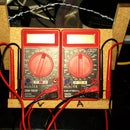Introduction: Circle Cutting Jig
For another project I'm working on I needed a way to cut many, many circles. Since the circle-cutting jig isn't necessarily tied to the other project I decided to write it up separately.
I used a bandsaw for this jig, but it could also be used for a disc sander, or even a table saw. (See also the amazing Dan Rojas' video on cutting circles with a table saw.)
The jig costs essentially nothing, is very easy and fun to use, and best of all opens ip a whole new level of capability to use on your future projects! For an example of the kinds of possibilities this opens up, see the disc sander pics on the last step.
This is also found on my project blog, here:
theheadlesssourceman.wordpress.com/2013/09/02/circle-cutting-jig/
(P.S. I just opened the licence up to full-fledged public domain so you can rest easy using it for your shcool / techshop / or whatever you want.)
Step 1: Build the Thing
All you need to build this is a couple peices of scrap wood. One is about 9x10 (doesn't have to be exactly that) and 5/16 or greater thick. The only other one you need is for a runner underneath to slide in the saw's miter slot. I found something that fit exaclty but you can also rip something down to fit.
To assemble, lay the runner board in the saw's miter slot. Align the bigger board so that it's a bit past the blade -- maybe 1/4 inch or so. Drill your pilot holes through the top board into the runner board beneath. Just enough to get a mark in the right spot. You DO NOT want to drill through into your tool!
Next, remove the runner and use a larger bit to go all the way through at the marks. Probably a good idea to counter-sink the bottom of the runner as well. Put two screws up through the bottom of the runner and fasten it to the top board.
Now, since you had made the top board go past the blade, you can just run it through the saw to cut it off square and perfect.
Next, use a T-square off the blade end to draw a line for your holes. Measuring VERY carefully, drill a 3/32 hole every half inch along that line and countersink the back side of all these holes. I chose 3/32 for the holes because it snugly a 2 inch (6d) bright nail, and because it makes a pretty standard pilot hole should I ever want to screw my finished circles to something.
The only other thing to do is to go along and mark each hole with the size it represents. Since I wanted everything in diameter, I marked each 1/2 inch spaced hole with a 1" increment label. You should mark these numbers on the bottom (runner) side since that's where you'll set it from.
Optional: You repeat the last paragraph and add other lines of holes to get other sizes of circles. For instance, I added a second row of numbers that's 1/8 inch diameter oversized. (Offset 1/16th inch further from the blade.) This way I can make circles with a little room to sand down to the exact size.
Step 2: Easy Set-Up
Set up is super easy. Just flip the jig upside-down and tap a 2 inch bright nail into whatever you want to cut.
Also clamp a stop block to your saw table such that the jig stops when the center line is exactly lined up with the saw blade.
Step 3: Use
1) Cut a square larger than the circle you want. (Don't make it exact. If the blade slips out of the wood it leaves a bump.)
2) Make an X by drawing a line from corner to corner both ways. This is the center. Drill a 3/32 hole there.
3) Push the wood down over the nail on the jig.
4) Push the jig and all into the blade, cutting a straight line till it hits the stop block.
5) Being careful of your fingers, slowly rotate the board 360 degrees. Also make sure the jig stays against the stop block.
That's it! These circles go really fast and turn out great every time!
Step 4: Epilogue
There you have it. Now you can make circles all the live-long day!
The only limitations I have found are:
1) Thickness. Best to keep it under 2" thick or the quality suffers.
2) Diameter. Circles smaller than 2" dia start to get your fingers rather close to the blade. Best to use a hole saw for things like this.
That being said, all the larger circles in 3/4 plywood turned out fantastic, with little or no sanding needed!













